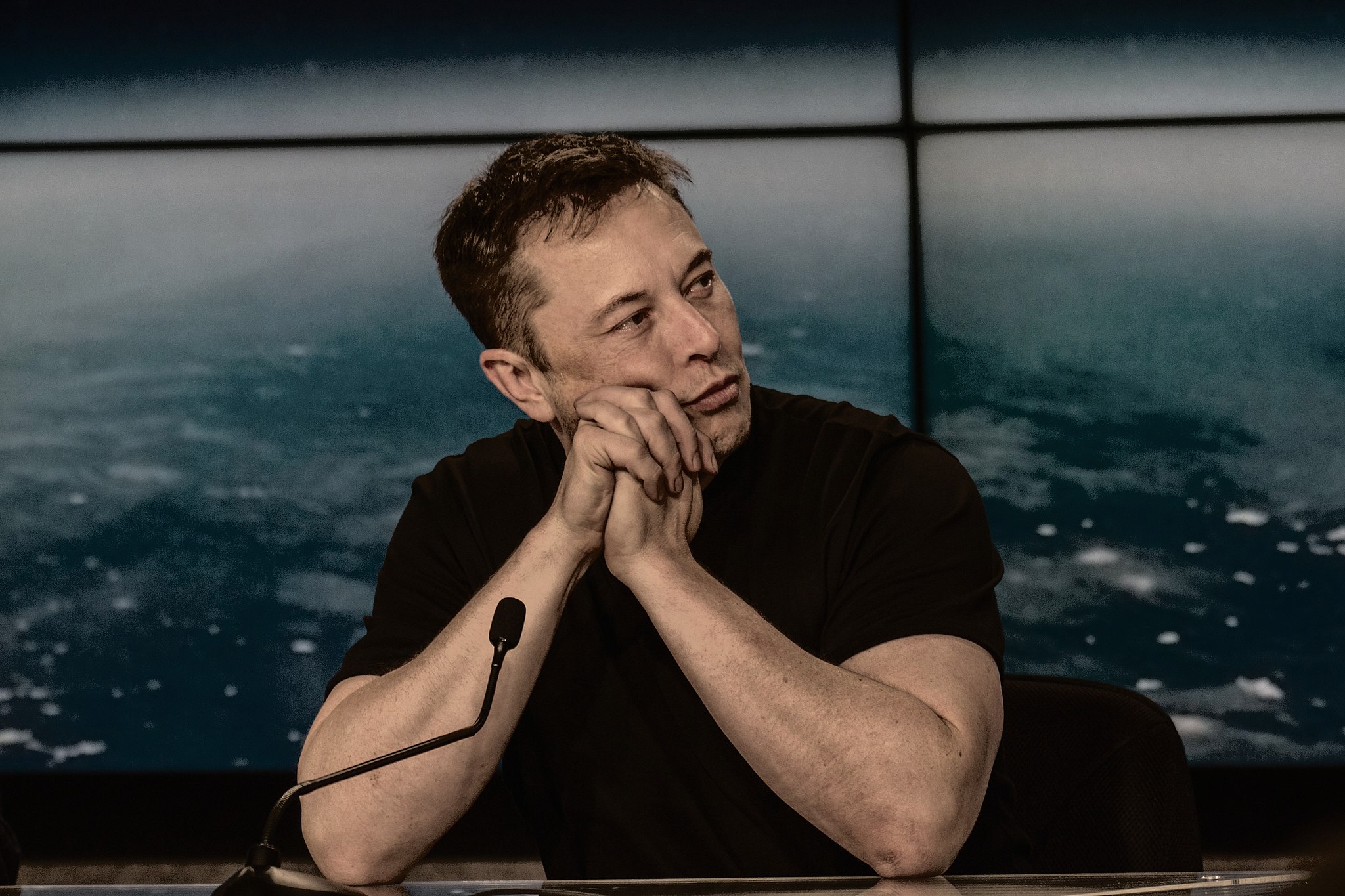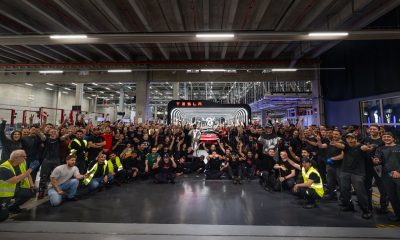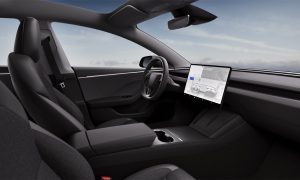

Investor's Corner
Tesla Gigafactory 3 passes major inspection amid V10’s introduction in China
Recent reports from local Chinese media have revealed that Tesla’s Gigafactory 3 complex has achieved yet another milestone. After a series of inspections on Gigafactory 3’s Phase 1 construction zone, officials have granted a ” comprehensive acceptance” of the site, paving the way for the start of Model 3 production operations in the near future.
Officials from the Lingang District Construction Project Management Service Center’s organized planning, construction, fire protection, lightning protection, archives, and other professional inspection departments conducted a meeting about their respective evaluations of the Gigafactory 3 Phase 1 site on September 12. Zhu Xiaolu, Vice President of Tesla Global and President of Greater China, was in attendance during the meeting.
As noted by local news agency Beijing News Finance, each of Gigafactory 3’s professional lines was extensively evaluated by the officials, together with the materials used by Tesla’s construction partner for the site. Each of Gigafactory 3’s lines in the Phase 1 zone was able to gain approval from the inspectors.
The newly granted comprehensive acceptance for Gigafactory 3’s Phase 1 construction stands as yet another indication that initial operations in the massive Shanghai-based site are about to begin. With inspections for the Phase 1 area completed, Tesla could start trial production runs of the Model 3 as soon as facilities such as the southwest substation are ready for activation.
Amidst the newly granted comprehensive acceptance of Gigafactory 3’s Phase 1 buildout, Tesla has also started rolling out its V10 Update to members of China’s Early Access Program. Social media posts from the local Tesla community indicate that V10 is full of fun, new features that include curated local applications geared towards the Chinese market, including popular video streaming platforms IQiyi and Tencent Video.
Tesla’s announcement of its V10 release in China was a bit more formal than its low-key release to members of the Early Access Program in the United States. Promotional images for V10, for example, featured a dedicated teaser for the new Tesla Theater function and its support for local streaming services. Based on social media reports from the local Tesla community, the V10 Update appears to be well appreciated. Images of V10’s updated visuals, for one, were described as a pleasant gift from the electric car maker just as the country is celebrating its Mid-Autumn Festival.
The success of Tesla’s push into the lucrative Chinese EV market will likely be determined by the company’s capability to effectively roll out the made-in-China Model 3 and Model Y from Gigafactory 3. The Shanghai-based site is designed to exclusively produce affordable versions of the Model 3 and the Model Y for the Chinese market. Thus, the facility is optimized for volume electric vehicle production, with an output that is appropriate for the country’s large auto market.
Tesla has implemented a number of optimizations to accomplish these goals. Unlike its electric car production process in the United States, which involves vehicle assembly being performed at the Fremont factory and battery and drive unit production being conducted in Gigafactory 1 at Nevada, the Shanghai Gigafactory 3 will produce batteries and drive units, and perform vehicle assembly in one site. This is expected to significantly improve Tesla’s manufacturing process, allowing the company to avoid most of the challenges it faced in its initial Model 3 ramp in the United States.
Investor's Corner
Goldman Sachs reduces Tesla price target to $285
Despite Goldman Sach’s NASDAQ: TSLA price cut to $285, Tesla boasts $95.7B in revenue & nearly $1T market cap.

Goldman Sachs analysts cut Tesla’s price target to $285 from $295, maintaining a Neutral rating.
The adjustment reflects weaker sales performance across key markets, with Tesla shares trading at $284.70, down nearly 18% in the past week. The analysts pointed to declining sales data in the United States, Europe, and China as the primary driver for the revised outlook. In the U.S., Tesla’s quarter-to-date deliveries through May fell mid-teens year-over-year, according to Wards and Motor Intelligence.
In Europe, April registrations plummeted 50% year-over-year, with May showing a mid-20% decline, per industry data. Meanwhile, the China Passenger Car Association (CPCA) reported a 20% year-over-year drop in May, despite a 5.5% sequential increase from April. Consumer surveys from HundredX and Morning Consult also shaped Goldman Sachs’ lowered delivery and EPS forecasts.
Goldman Sachs now projects Tesla’s second-quarter deliveries to range between 335,000 and 395,000 vehicles, with a base case of 365,000, down from a prior estimate of 410,000 and below the Visible Alpha Consensus of 417,000. Despite these headwinds, Tesla’s financials remain strong, with $95.7 billion in trailing twelve-month revenue and a $917 billion market capitalization.
Regionally, Tesla’s challenges are stark. In Germany, the German road traffic agency KBA reported Tesla’s May sales dropped 36.2% year-over-year, despite a 44.9% surge in overall electric vehicle registrations. Tesla’s sales fell 29% last month in Spain, according to the ANFAC industry group. These declines highlight shifting consumer preferences amid growing competition.
On a positive note, Tesla is making strategic moves. The Model 3 and Model Y are part of a Chinese government campaign to boost rural sales, potentially mitigating losses. Piper Sandler analysts reiterated an Overweight rating, emphasizing Tesla’s supply chain strategy.
Alexander Potter stated, “Thanks to vertical integration, Tesla is the only car company that is trying to source batteries, at scale, without relying on China.”
As Tesla navigates these delivery challenges, its focus on innovation and supply chain resilience could help it maintain its edge in the electric vehicle market despite short-term hurdles.
Elon Musk
Elon Musk explains Tesla’s domestic battery strategy
Elon Musk responded to a new note from an analyst that highlighted Tesla’s battery strategy.

Tesla CEO Elon Musk explained the automaker’s strategy for building batteries from top to bottom in a domestic setting as the company continues to alleviate its reliance on Chinese materials, something other companies are too dependent on.
With the Trump Administration, it is no secret that the prioritization of U.S.-built products, including sourcing most of the materials from American companies, is at the forefront of its strategy.
The goal is to become less dependent on foreign products, which would, in theory, bolster the U.S. economy by creating more jobs and having less reliance on foreign markets, especially China, to manufacture the key parts of things like cars and tech.
In a note from Alexander Potter, an analyst for the firm Piper Sandler, Tesla’s strategy regarding batteries specifically is broken down.
Potter says Tesla is “the only car company that is trying to source batteries, at scale, without relying on China.”
He continues:
“Eventually, Tesla will be making its own cathode active materials, refining its own lithium, building its own anodes, coating its own electrodes, assembling its own cells, and selling its own cars; No other US company can make similar claims.”
Musk, who spent time within the Trump White House through his work with the Department of Government Efficiency (DOGE), said that Tesla is doing the “important” work of localizing supply chains as the risks that come with being too dependent on foreign entities could be detrimental to a company, especially one that utilizes many parts and supplies that are manufactured mostly in China.
It is important, albeit extremely hard work, to localize supply chains to mitigate geopolitical risk
— Elon Musk (@elonmusk) June 3, 2025
Tesla has done a lot of work to source and even manufacture its own batteries within the United States, a project that has been in progress for several years but will pay dividends in the end.
According to a 2023 Nikkei analysis, Tesla’s battery material suppliers were dominated by Chinese companies. At the time, a whopping 39 percent of the company’s cell materials came from Chinese companies.
This number is decreasing as it operates its own in-house cell and material production projects, like its lithium refinery in Texas.
It also wants to utilize battery manufacturers that have plans to build cells in the U.S.
Panasonic, for example, is building a facility in Kansas that will help Tesla utilize domestically-manufactured cells for its cars.
Elon Musk
Tesla stock: Morgan Stanley says eVTOL is calling Elon Musk for new chapter
Could Tesla dive into the eVTOL market? Morgan Stanley takes a look.

Tesla shares are up nearly 20 percent in the past month, but that is not stopping the only trillion-dollar automaker from attracting all types of new potential sectors to disrupt, at least from an investor and analyst perspective.
Morgan Stanley’s Adam Jonas is not one to shy away from some ideas that many investors would consider far-fetched. In a recent note, Jonas brought up some interesting discussion regarding Tesla’s potential in the eVTOL industry, and how he believes CEO Elon Musk’s answer was not convincing enough to put it off altogether.
Tesla’s Elon Musk says electric planes would be ‘fun problem to work on’
Musk said that Tesla was “stretched pretty thin” when a question regarding a plane being developed came up. Jonas said:
“In our opinion, that’s a decidedly different type of answer. Is Tesla an aviation/defense-tech company in auto/consumer clothing?”
Musk has been pretty clear about things that Tesla won’t do. Although he has not unequivocally denied aviation equipment, including planes and drones, as he has with things like motorcycles, it does not seem like something that is on Musk’s mind.
Instead, he has focused the vast majority of his time at Tesla on vehicle autonomy, AI, and robotics, things he sees as the future.
Tesla and China, Robotics, Pricing
Morgan Stanley’s note also discussed Tesla’s prowess in its various areas of expertise, how it will keep up with Chinese competitors, as there are several, and the race for affordable EVs in the country.
Tesla is the U.S.’s key to keeping up with China
“In our view, Tesla’s expertise in manufacturing, data collection, robotics/ physical AI, energy, supply chain, and infrastructure are more critical than ever before to put the US on an even footing with China in embodied AI,” Jonas writes.
It is no secret that Tesla is the leader in revolutionizing things. To generalize, the company has truly dipped its finger in all the various pies, but it is also looked at as a leader in tech, which is where Chinese companies truly have an advantage.
Robotics and the ‘Humanoid Olympics’
Jonas mentioned China’s recent showcasing of robots running half marathons and competing in combat sports as “gamification of robotic innovation.”
Tesla could be at the forefront of the effort to launch something similar, as the analyst predicts the U.S. version could be called “Humanoid Ninja Warrior.”
Pricing
Tesla is set to launch affordable models before the end of Q2, leaving this month for the company to release some details.
While the pricing of those models remains in limbo with the $7,500 tax credit likely disappearing at the end of 2024, companies in China have been able to tap incredibly aggressive pricing models. Jonas, for example, brings up the BYD Seagull, which is priced at just about $8,000.
Tesla can tap into an incredibly broader market if it can manage to bring pricing to even below $30,000, which is where many hope the affordable models end up.
During the Q3 2024 Earnings Call, Musk said that $30,000 is where it would be with the tax credit:
“Yeah. It will be like with incentive. So, 30K, which is kind of a key threshold.”
-

 News6 days ago
News6 days agoTesla to lose 64 Superchargers on New Jersey Turnpike in controversial decision
-

 News2 weeks ago
News2 weeks agoTesla’s new Model S and X spotted, but they leave a lot to be desired
-

 Elon Musk2 weeks ago
Elon Musk2 weeks agoTesla set for ‘golden age of autonomous’ as Robotaxi nears, ‘dark chapter’ ends: Wedbush
-

 News1 week ago
News1 week agoTesla gets major upgrade that Apple users will absolutely love
-

 News2 weeks ago
News2 weeks ago‘Tesla tax’ could be no more in United Kingdom
-

 Elon Musk1 week ago
Elon Musk1 week agoTesla investors demand 40-hour workweek from Elon Musk
-

 Elon Musk3 days ago
Elon Musk3 days agoElon Musk explains Tesla’s domestic battery strategy
-

 News2 weeks ago
News2 weeks agoTesla Cybertrucks join Jalisco’s police fleet ahead of FIFA World Cup




















